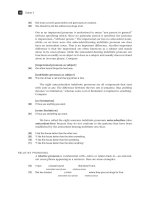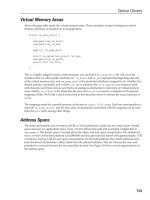Effective Project Management Traditional, Adaptive, Extreme Third Edition phần 10 pdf
Bạn đang xem bản rút gọn của tài liệu. Xem và tải ngay bản đầy đủ của tài liệu tại đây (615.83 KB, 54 trang )
project executives whose focus is strategic. At the end of a spoke is a regional
PSO, which has operational responsibilities for the unit they represent. Obvi-
ously, the hub-and-spoke configuration works best in those organizations that
have a more mature approach to project management. It is not a structure for
the organizations new to project management.
Organizational Placement of the PSO
There are three organizational placements for the PSO, as shown in Figure 21.1.
At the enterprise level they are usually called by some name like Enterprise
PSO (EPSO) that suggests they serve the entire enterprise. There are two vari-
ations of EPSOs that we have seen—centralized or decentralized:
■■ In the centralized version the EPSO provides all of the services to all proj-
ect teams corporate-wide that any PSO would provide.
■■ The decentralized version often has a policy and procedure responsibility
with satellite PSOs providing the actual functions in accordance with the
established policy and procedures.
Figure 21.1 Organizational placement of the PSO.
CEO
IT Finance EPSOOperations
App Dev Systems Support IT PSO
Project
Project
Project
Project
Project
PO
PO
PO
PO
PO
Project Support Office
411
25 432210 Ch21.qxd 7/2/03 9:34 AM Page 411
Both models can be effective. The size of the organization with respect to the
number of projects needing support is the best determinant of structure, the
decentralized structure favoring the larger organization. There really are no
hard-and-fast rules here.
The PSO can also serve the needs of a significant part of the enterprise—such
as at the division or business unit level. The most common example is the
information technology division. Here the PSO serves the needs of all the IT
professionals in the organization (IT PSO in Figure 21.1, for example). Because
this PSO is discipline-specific, it will probably offer project support services
tailored to the needs of the information technology project. It may also offer
services specific to the needs of teams that are using various systems develop-
ment processes. In other words, a division-level PSO may offer not only proj-
ect management support services but also services specific to the discipline.
The PSO can also serve the needs of a single program. As shown in the Figure
21.1, there may be several of these programs even within a single division. This
is a common occurrence in the information technology division. These PSOs
are temporary. When the program that they support is completed, the PSO is
disbanded.
How Do You Know You Need a PSO?
However you slice it, the PSO is established for the sole purpose of improving
the practice of project management for the group of projects and project man-
agers over whom it has stewardship. The PSO is an investment, and its ROI is
measured in terms of cost avoidance. That cost avoidance is a direct result of a
significant reduction in project failures for which the PSO is held directly
responsible and accountable.
The Standish Group Report
The reasons for project failure have been investigated and reported in detail
for several years. One of the most thorough research efforts into the reasons for
project failure is the work of the Standish Group (we discussed this research in
Chapter 2 as well). Their most recent report is “Chronicles 2000.” In the study
reported there, they surveyed several hundred IT executives asking them why
projects fail. The top 10 reasons why IT projects fail according to this study
were as follows. IT projects fail due to a lack of:
1. Executive management support
2. User involvement
3. Experienced project manager
Chapter 21
412
25 432210 Ch21.qxd 7/2/03 9:34 AM Page 412
4. Clear business objectives
5. Minimized scope
6. Standard infrastructure
7. Firm basic requirements
8. Formal methodology
9. Reliable estimates
10. Skilled staff
After reviewing the major functions that the PSO provides, you can see that a
PSO is uniquely positioned to mitigate each of these 10 reasons for project fail-
ure. In fact, it is the only organizational entity that is so positioned.
Spotting Symptoms That You Need a PSO
Several symptoms provide you with clues that you might need a PSO:
Project failure rates too high. The data is all too familiar to us. Reports show
70 percent and higher regardless of how you define failure. That is simply
unacceptable. Many of the reasons for those high numbers are probably
found in the list from the Standish Group. Those that relate to the project
management approach that was used—namely, user involvement, clear
business objectives, minimized scope, standard infrastructure, firm basic
requirements, and formal methodology—can be addressed by choosing the
correct approach (TPM, APF, or xPM). It is our contention that by choosing
the appropriate approach, the organization can make a serious impact on
failure rates.
Training not producing results. We are not aware of any systematic study of
the root causes of training ineffectiveness. The possible causes are inappro-
priate materials, inappropriate delivery, no follow-through on behavioral
changes after training, or no testing of skill acquisition. Training needs to be
taken seriously by those who attend the training. They need to be held
accountable for applying what they have learned, and there needs to be
ways to measure that application. We are amazed at how many training
professionals and curriculum designers are not familiar with Kirkpatrick’s
model. The interested reader can consult Donald L. Kirkpatrick’s Evaluating
Training Programs, Second Edition (Berrett-Koehler Publishers, Inc., 1998) In
our experience, project reviews that are held at various milestones in the life
of the project are excellent points at which to validate the application of
training. If there is not clear evidence that training has been applied, some
corrective action is certainly called for.
Project Support Office
413
25 432210 Ch21.qxd 7/2/03 9:34 AM Page 413
HR project staff planning not effective. Organizations need to do a better
job of defining the inventory of project staff skills and the demand for
those skills by project. There needs to be a concerted effort to match the
supply to the demand and to make better staffing assignments to projects.
The PSO is the best place for this responsibility to be carried out.
Can’t leverage best practices. The PSO is the best place to collect and dis-
tribute best practices. Project status meetings and project reviews are the
place to identify best practices. The PSO, through some form of bulletin
board service, is the best place to distribute that information. In the
absence of that service, the collection and distribution of best practices
isn’t going to happen.
Don’t have control of the project portfolio. Many senior managers don’t
know the number of projects that are active. They haven’t made any effort
to find out and to be selective of those projects that are active. That behav-
ior has to stop if there is any hope of managing the project work that goes
on in the organization. The PSO is the clear choice for stewardship of that
portfolio. At least, it can be the unit that assembles project performance
data and distributes it to the decision makers for their review and action.
No consistency in project reporting. Without a centralized unit responsible
for the reporting process, consistent and useful reporting isn’t going to hap-
pen. Again, the PSO is the clear choice to establish the reporting structure
and assist in its use.
Too many resource scheduling conflicts. Most organizations operate with
some form of matrix structure. Resources are assigned from their functional
unit to projects at the discretion of the functional unit manager. In such situ-
ations resource conflicts are unavoidable. The individuals that are assigned
to projects are torn between doing work for their functional unit and doing
work for the project to which they have been assigned. None of this is news
to you. One solution to resource scheduling conflicts is to use the PSO as
the filter through which project staffing requests and staffing decisions are
made. The major benefit of this approach is that it takes the project manager
off the hot seat and puts the responsibility in the PSO where it can be more
equitably discharged.
Gap between process and practice. This is a major problem area for many
organizations. They may have a well-documented process in place, but
without any oversight and compliance function in place, they are at the
mercy of the project manager to use or not use the process. The PSO is the
only unit that can close this gap. The PSO puts the process in place with
the help of those who will be held accountable for its use. The PSO,
through project performance reviews, can determine the extent of that
gap and can put remedial steps in place to close it.
Chapter 21
414
25 432210 Ch21.qxd 7/2/03 9:34 AM Page 414
Establishing a PSO
When you are planning for a PSO, three critical questions must be answered.
One of them deals with defining a desired future for your organization’s
PSO—the goal, so to speak. But to reach that goal, you have to assess where
you currently are with respect to that goal. The answer to that question identi-
fies a gap between the current state and the future state. That gap is removed
through the implementation plan for your PSO. This is the definition of a stan-
dard gap analysis. The three major questions, then, arranged chronologically,
are as follows:
■■ Where are you?
■■ Where are you going?
■■ How will you get there?
Before you attempt to answer those questions, you need a foundation for
answering them. The Software Engineering Institute (SEI) provides just the
foundation you need. Their five-level model described in the next section also
gives you a foundation on which you can plan for the further growth and mat-
uration of our PSO.
PSO Stages of Growth
Over the past several years, the Software Engineering Institute at Carnegie Mel-
lon University has developed a maturity model for software engineering. It has
gained wide support and has become a standard of the software development
profession. The model is called the Capability Maturity Model (CMM). It has
recently been adapted to project management in the form of a Project Manage-
ment Maturity Model (PMMM). We will use the five maturity levels of the
PMMM to answer these questions: Where are you and where are you going?
Figure 21.2 offers a graphic depiction and brief description of each of the matu-
rity levels of the PMMM.
Level 1: Initial
Level 1 is the level where everyone basically does as he or she pleases. There
may be some processes and tools for project management, and some may be
using them on an informal basis. Project management training is nonexistent,
and help may be available on an informal basis at best. There doesn’t appear
to be any signs of organization under project management.
Project Support Office
415
25 432210 Ch21.qxd 7/2/03 9:34 AM Page 415
Figure 21.2 Project management maturity levels.
Level 2: Repeatable
Level 2 is distinguished from Level 1 in that there is a documented project
management process available. It is used at the discretion of the project man-
ager. There is some training available for those who are interested. The only
sign of a PSO is through some part-time support that will help a project team
on an as-requested basis.
Level 3: Defined
The transition from Level 2 to Level 3 is dramatic. The project management
processes are fully documented, and project management has been recognized
as critical to business success by senior management. A formal PSO is estab-
lished and staffed and given the responsibility of ensuring enterprise-wide
usage of the methodology. Enforcement is taken seriously. A solid training
curriculum is available. There is some sign that project management is being
integrated into other business processes.
Level 4: Managed
Successful project management is viewed as a critical success factor by the
organization. A complete training program and professional development
program for project managers is in place. The PSO is looked upon as a busi-
ness, and project portfolio management is of growing importance. The project
portfolio is an integral part of all business planning activities.
PSO Maturity Levels
Ad hoc-
Support but
no training
from the
PSO.
Defined PM
processes
with reactive
support from
the PSO and
intro training.
Integrated
use of defined
PM processes
with PSO
oversight,
proactive
support, and
more training.
PSO manages
the project
portfolio as
an integral
part of all
business
processes
and more
extensive
training.
Continuous
improvement
of all PSO
services and
processes.
Level 1
Level 2
Level 3
Level 4
Level 5
Chapter 21
416
25 432210 Ch21.qxd 7/2/03 9:34 AM Page 416
Level 5: Optimized
The PSO is the critical component of a continuous quality improvement
program for project management. Progress in the successful use of project
management is visible, measured, and acted upon.
Planning a PSO
You can now put the pieces of a plan together. Based on what we have discussed
so far, your plan to establish a PSO might look something like Figure 21.3.
Before you can begin the activities shown in Figure 21.3, however, you have to
write the Project Overview Statement (POS) for the PSO.
CROSS-REFERENCE
For a more detailed discussion of the components of a POS and what goes into writing
one, see Chapter 3.
The POS
Figure 21.4 is an example POS for a PSO implementation project submitted by
Sal Vation.
Figure 21.3 A plan to establish a PSO.
Form the
PSO Task
Force
Assess
management's
opinions of the
role of PM
Assess the
project
manager/client
relationship
Assess how
the current
methodology
is being used
Assess the
current PM
methodology
Define PSO
mission,
functions and
organization
Plan and
deploy the
PSO
Disband the
PSO Task
Force
Where are you?
Where do you
want to go?
How will you
get there?
Time
Project Support Office
417
25 432210 Ch21.qxd 7/2/03 9:34 AM Page 417
Figure 21.4 An example Project Overview Statement for a PSO implementation project.
The next sections take a quick look at what Sal submitted.
Problem/Opportunity
First, note that the statement describes a business condition that needs no
defense or further clarification. Anyone, especially the executive committee,
who reads it will understand it and agree with it. The importance of this state-
ment will determine whether or not the reader will continue to the goal state-
ment. In this case, the situation is grave enough so their continued reading is a
foregone conclusion.
To restore our lost market share, we must quickly develop our capabilities in the
customized furnishings business but are unable to because our project management
processes cannot support the needs of the product development teams.
Provide a fully mature and comprehensive portfolio of project managment support
services to all project teams in less than four years.
1. Provide off-the-shelf and customized project management training.
2. Develop and document a standard project management process to support all of
our project teams with special focus on product development teams.
3. Establish a projects review process to monitor and enforce compliance with our
project management processes.
4. Establish a portfolio management process for all customized projects.
5. Create a professional development program for all project managers.
6. Design and implement a continuous quality improvement process for project
management.
1. Over 50% of all PMs will receive basic training by the end of 2003 Q1.
2. Project quarterly success rates will increase from current 35% to 70% by 2003 Q3.
3. At least 90% of all projects begun after 2003 Q3 will use the new O & P project
management process.
4. 100% of all PMs will receive training in the O & P project management process
by the end of 2003 Q4.
5. 90% of all PMs will have a professional development program in place by 2003 Q4.
6. The PSO will reach maturity level 2 no later than Q3 2003, maturity level 3 no
later than Q4 2004, maturity level 4 no later than Q2 2006, and maturity level 5
no later than Q4 2006.
7. Market share will be restored to 100% of its highest level no later than Q4 2006.
1. Business unit managers will resist change in their operating procedures.
2. The customized furnishings market is not as strong as forecasted.
3. Project managers will continue to practice their old ways.
Problem Opportunity
Goal
Objectives
Success Criteria
Assumptions, Risks, Obstacles
PROJECT
OVERVIEW
STATEMENT
PSO Implementation PSO.001 Sal Vation
Project Name Project No. ProjectManager
Prepared By Date Approved By Date
Sal Vation Del E. Lama1/3/2003 1/6/2003
Chapter 21
418
25 432210 Ch21.qxd 7/2/03 9:34 AM Page 418
Goal
The statement is clean and crisp. It states what will be done and by when. Note
that it is phrased so that the project is expected to deliver results before the
expected completion date. Sal recognizes the importance of early results to the
executive committee and doesn’t want the stated time line to shock them and
perhaps risk their approval.
Objectives
The objective statements expand and clarify the goal statement and suggest
interim milestones and deliverables.
Success Criteria
Sal has expressed the success criteria in specific and measurable quantitative
terms. This is very important. In this case the criteria will help the executive
committee understand the business value of the project. It is the single most
important criteria Sal can present to them at this time to help them decide
whether the project is worth doing.
Assumptions, Risks, Obstacles
Sal has called to the attention of the executive committee anything that he feels
can potentially compromise the success of the project. These statements serve
two purposes:
■■ They highlight for senior managers some of the potential problems that
they might be able to mitigate for the project team.
■■ They provide some risk data for the financial analysts to estimate the
expected return on the investment in a PSO.
They will consider the success criteria versus risk to determine the expected
business value that can result from this project. In case there were other projects
vying for the same resources, the analysts would have a comparable statistic to
use to decide where to spend their resources.
Planning Steps
Sal will eventually get approval to move into the details of planning the project
in anticipation of getting executive committee approval of the plan so that he
and his team can get to work. Sal might expect a few iterations of the POS before
he gets that approval to proceed with planning. In our experience senior man-
agers often question success criteria, especially with reference to its validity.
Project Support Office
419
25 432210 Ch21.qxd 7/2/03 9:34 AM Page 419
Forming the PSO Task Force
The PSO task force forms the strategy group for this project. They are to be con-
sidered members of the project team. Their membership should be managers of
those business units that will be impacted by the PSO. The size of the enterprise
determines how many members there will be. A task force of four to six should
work quite well, but a task force of 15 would be counterproductive. Without the
support and commitment of each task force member, the PSO it is unlikely to
succeed. Because their operations are likely to be affected by the PSO, they must
be a part of its mission and have an opportunity to be heard as decisions are
made on the mission, functions, and services the PSO will provide.
Measuring Where You Are
Several metrics have been developed to quantitatively measure the maturity
level of your project management processes. We have developed one that
consists of over 800 yes/no questions. (The interested reader should consult us
at for details on this proprietary product.) These questions
cover all five maturity levels for all 39 project management processes identi-
fied by PMI in their PMBOK. Figure 21.5 shows the results for a recent assess-
ment for one of our clients. The data on each of the 39 processes have been
aggregated to the knowledge area level.
Figure 21.5 Maturity level data for nine knowledge areas of PMBOK.
5
4
3
2
1
Practice Baseline
Practice Problem
Best Practices
Integration
Scope
Time
Quality
HR
Communications
Risk
Procurement
Cost
Chapter 21
420
25 432210 Ch21.qxd 7/2/03 9:34 AM Page 420
This one graphic conveys a lot of information about this organization’s project
management maturity levels. First of all, the dashed line shows the maturity
level of each knowledge area as documented in the organization’s project
management methodology. The box and whisker plots are maturity-level data
on how project management was practiced in several projects that were
reviewed in the same quarter. The box and whisker plot is a summarized view
of the data points for each project on a single knowledge area. Each box dis-
plays the middle 50 percent of the data. The endpoints of the whiskers denote
the extreme data points. The color coding denotes the status of the knowledge
area. A red box indicates a process whose practice is significantly below the
maturity level of the baseline process. A yellow box indicates a process whose
practice is significantly above the maturity level of the baseline process. For
example, take a look at the Scope Management knowledge area. The projects
that were reviewed demonstrated a maturity level range from a low of 1.2 to a
high of 4.1. The middle half of the data points range from 1.8 to 2.9. The Scope
Management knowledge area was assessed at a maturity level of 3.5. In all
cases where there is a maturity level below target or above target, it is an area
that needs further investigation. The investigation should look for answers to
the less than nominal maturity and take the necessary corrective steps to raise
the level of maturity of that knowledge area. In those cases where the knowl-
edge area is found to be performing above nominal, the investigation should
look for the reasons for that exemplary performance and for ways to share
their findings with other project teams.
In determining where the organization is with respect to project management,
there are two threads of investigation:
■■ The first is the organizational environment that the PSO will function in.
This involves assessing the opinions of the managers whose business
units will be impacted. Oftentimes this can be done with face-to-face
interviews of key managers.
■■ The second is an attempt to assess the current relationship between proj-
ect managers and the clients they serve. In this case the clients will be
internal business units and external customers who buy their products.
An assessment tool that we have developed at Enterprise Information Insights,
Inc., that has been quite successful in practice is the Project Manager Compe-
tency Assessment (PMCA). It is an assessment of a project manager’s project
management competencies. (Contact us at for information on
how to acquire the tool.) Figure 21.6 is a report from that assessment tool.
Project Support Office
421
25 432210 Ch21.qxd 7/2/03 9:34 AM Page 421
Figure 21.6 An example project manager competency assessment.
This PMCA reports findings in four major areas (business competency, personal
competency, interpersonal competency, and management competency) as they
relate to the individual’s project management behaviors. There are a total of 18
competencies spread across these four areas. Each one uses the box and whisker
plot to summarize the opinions of the assessors. In this case there were eight
assessors. The endpoints of the box and whisker plots denote the extreme data
points. The hollow rectangle is the middle half of the data. The filled rectangle is
the average of all assessors. The bolded vertical line is the individual’s self-
assessment. This individual has a higher self-assessment of herself than do the
managers who provided the competency data. This is especially evident in busi-
ness awareness, business partnership, initiative, conceptual thinking, resource-
ful use of influence, and motivating others. This person should be advised to
Business Awareness
Business Partnership
Commitment to Quality
Does not meet minimum requirements
Meets Team Leader requirements
Meets Project Manager requirements
Meets Senior Project Manager requirements
Meets Program Manager requirements
Initiative
Information Gathering
Conceptual Thinking
Self Confidence
Concern for Credibility
Flexibility
Interpersonal Awareness
Organizational Awareness
Anticipation of Impact
Resourceful Use of Influence
Motivating Others
Communication Skills
Developing Others
Planning
Monitoring & Controlling
Business Competencies
Personal Competencies
Interpersonal Competencies
Management Competencies
Chapter 21
422
25 432210 Ch21.qxd 7/2/03 9:34 AM Page 422
take a close look at how she sees herself relative to how others see her. This self-
inflated phenomenon is not unusual. We have seen it time and time again in
many of these assessments. People are simply not aware of how they affect
others. As a group, her interpersonal competencies are held in high regard by
her fellow workers. Her personal competencies, especially initiative, conceptual
thinking, and self-confidence, may be problematic.
If either of these two assessments, either the maturity level of your project
management processes or the project manager competency assessment,
uncovers problems, an intervention may be needed prior to any further PSO
planning. For the purposes of our exercise, the assessments have shown us
that the organization is ready to move forward and strongly supports the
creation of a full-service PSO.
The next step is to take a look at the existing methodology. There are two areas
of investigation:
■■ The first is to assess the maturity level of the project management
processes that are in place. This can be done by using commercially avail-
able tools (such as Project Management Maturity Assessment).
■■ The second area of investigation is to assess how project teams are using
that methodology. Again, there are commercially available tools for this
assessment (Project Management Competency Assessment, for one).
Please contact us at for more information on these and
other similar assessment tools.
For the purposes of this example, assume those assessments show that the
organization is at Level 1 maturity both in terms of their project management
processes and the practice of those processes.
Establishing Where You Want To Go
The future of the organization in the example seems to rest on its ability to
restore market share. As expressed in the POS, Sal has as a long-term goal the
achievement of level 5 maturity in the PSO. His strategy will be to achieve that
in phases, with each phase providing business value to the organization. The
PSO is expected to be a full-service PSO. Its mission, functions, and organiza-
tion are given in Table 21.1.
Table 21.1 Example PSO Mission, Functions, and Organization
MISSION
To provide the project management services and support needed to establish a mar-
ket leadership position for the organization in the customized furnishings business.
(continued)
Project Support Office
423
25 432210 Ch21.qxd 7/2/03 9:34 AM Page 423
Table 21.1 (continued)
FUNCTIONS
All project administrative services
Project management processes to support all project types
Comprehensive software for all phases of product development
A customized and complete PM training curriculum
A revolving staff of consulting project managers
A professional development program for project managers
ORGANIZATION
An enterprise-wide unit attached to the president’s office
EPSO director will be a three-year renewable appointed position
Permanent staff consists of:
Project administrator to deliver support services
Manager of methods and tools
Senior project manager consultant
Project manager consultant
Curriculum development specialist
Senior trainer
Trainer
The long-term goal of the PSO is to ensure project success. It should be obvi-
ous that goal means at least the attainment of Level 3 maturity. Without a doc-
umented process in place and in use by all teams, it is unlikely that there will
be any measurable increase in the rate of project success.
On the other hand, to casually state that Level 4 maturity is the goal of the PSO
is not appropriate. That is clearly a business decision. To attain Level 4 maturity
is a big step. It is very costly in terms of the extent of change in the organization.
We would liken that change to the evolution of the enterprise to a projectized
organizational structure. To move from Level 4 to Level 5 is a matter of imple-
menting a continuous quality improvement process within the PSO. That is far
less traumatic and usually involves not much more than putting teeth into a proj-
ect review process and a concerted effort to capture and implement best practices
from the organization’s projects, as well as projects external to the organization.
Referring for a moment back to the data in Figure 21.5, because the middle half of
the data points all fall below the average of 3.5, Scope Management needs some
improvement. This would be an area where a continuous quality improvement
effort would focus. The results of a continuous quality improvement effort in
Chapter 21
424
25 432210 Ch21.qxd 7/2/03 9:34 AM Page 424
Scope Management might look something like the hypothetical data dis-
played in Figure 21.7. Note that not only has the process baseline maturity
level improved from 3.5 to 4.1 during the period from 3/2002 to 12/2002, but
the mid-range of the maturity level of the practice has moved from (1.8–2.9) to
(3.9–4.3). The maturity level of the practice of Scope Management has
increased significantly, and its range has decreased. This is a marked improve-
ment! If this organization had set as its goal to increase the Scope Management
maturity level of its process and its practice to 4.0, it would have achieved that
goal.
Establishing How You Will Get There
It goes without saying that the lower your current project management matu-
rity level is, the more challenging it will be to move to Level 3 or higher matu-
rity. Level 3 is where the PSO can really begin to make an impact on the
practice of project management. It is at this level that the organization is fully
bought into project management. Teams must use it, and the PSO is monitor-
ing that usage. Best practices are identified through project reviews and folded
back into the methodology. All signs are positive. Figure 21.8 gives a brief
description of what actions should be taken to move from one level to the next.
Sal’s plan consists of four phases. Each phase ends with a milestone that signi-
fies the attainment of the next level of maturity. So Phase One is complete
when the organization has reached maturity Level 2 in the PSO. Phases Two,
Three, and Four are similarly defined. Within each phase there are a number of
deliverables that add business value. These deliverables have been prioritized
to add business value as soon as possible. Figure 21.9 describes the high-level
plan through all four phases.
Figure 21.7 Continuous quality improvement of scope management.
5
4
3
2
1
Scope Management Process Baseline
Scope Management Practice Problem
3/2002
6/2002
9/2002
12/2002
Project Support Office
425
25 432210 Ch21.qxd 7/2/03 9:34 AM Page 425
Current
PSO Maturity
Level
INITIAL
(1)
• Some defined PM processes are available.
• Informal support to teams as requested.
• No PM training is available.
Characteristics of PSOs at
This Maturity Level
Initiatives that Will Move the PSO
to the Next Maturity Level
• A documented PM process is in place.
• Part-time support to teams available.
• Limited PM training is available.
REPEATABLE
(2)
DEFINED
(3)
MANAGED
(4)
OPTIMIZING
(5)
• PSO responsible for professional development.
• Complete PM training is available.
• Project portfolio is managed as a business.
• Fully documented and supported PM process.
• Full-time support to teams is available.
• All project teams are using the PM process.
• PM processes are integrated with other processes.
• More extensive PM training is available.
• A continuous improvement process is in place.
• There is measured improvement in project success.
• Assemble a task force to establish a PM process.
• Document the PM process.
• Make PM training available.
• Establish programs to increase PM process usage.
• Establish a full-time PSO staff to support teams.
• Monitor and enforce compliance.
• Increase available PM training.
• PSO begins to identify and adopt best practices.
• Metrics are defined to track process quality.
• Project reviews are used to monitor compliance.
• Projects are made part of the business plan.
• Put project portfolio management in the PSO.
• Give the PSO an active role in project staffing.
• Offer more extensive training.
• Create a career development program in the PSO.
• Staff project managers in the PSO.
Chapter 21
426
Figure 21.8
How to move to the next maturity level.
25 432210 Ch21.qxd 7/2/03 9:34 AM Page 426
Figure 21.9 PSO plan overview.
Challenges to Implementing a PSO
Too many executives have the impression that a PSO is mostly a clerical func-
tion and that establishing one is not too difficult. Nothing could be further
from the truth. J. Kent Crawford provides a compelling discussion of some of
those challenges in The Strategic Project Office: A Guide to Improving Organiza-
tional Performance, published by Marcel Dekker in 2001. Crawford’s challenges
are as follows:
■■ Speed and patience
■■ Leadership from the bottom up
■■ A systems thinking perspective
■■ Enterprise-wide systems
■■ Knowledge management
■■ Learning and learned project organizations
■■ Open communications
Offer basic PM training.
Design and document the O&P Project Management Methodology (PMM).
Offer O&P PMM training.
Customize the PM training to the new O&P PMM.
Design and implement a project review process.
Establish a project portfolio management process.
Design and implement a quality improvement process.
Maturity
Level 2
Q1
2003
Q1
2004
Q1
2005
Q1
2006
Q1
2007
Maturity
Level 3
Maturity
Level 4
Maturity
Level 5
Project Support Office
427
25 432210 Ch21.qxd 7/2/03 9:34 AM Page 427
Speed and Patience
Effectively deploying a PSO can require two to five years for full implementa-
tion. That is a long time. According to the Standish Group research, the longer
the project, the higher the probability of project failure. The way out of this
apparent dilemma is to plan the PSO deployment in stages. Each stage must
deliver visible and measurable value to the organization. To do otherwise is to
court disaster.
Leadership from the Bottom Up
A major strategy in putting a PSO in place is a bottom-up strategy. At the
department or project level, you will have to demonstrate value by showing
the results that a PSO can achieve. By way of example then, others in the orga-
nization will see that success and ask how they can do it in their own areas.
This grassroots effort will be contagious and will be one of the keys to a suc-
cessful PSO implementation over time.
A Systems Thinking Perspective
This point goes to the very heart of a PSO contributing at the corporate level.
At some point in the implementation of the PSO, senior managers will begin to
see how an effectively managed project portfolio can contribute to corporate
goals. Senior managers begin to think about the portfolio and not just the
projects that make it up. This transition from Level 3 to Level 4 maturity is the
result of a major discovery by senior management. They begin to think in
terms of a systems perspective.
Enterprise-wide Systems
This characteristic is clearly one of a Level 4 organization. The integration of
the project data into the other corporate databases allows senior managers the
tools they need to make enterprise-wide business decisions where projects are
the strategic components of their business plans. Making this jump from sin-
gle project focus to strategic portfolio focus is the sign of a Level 4 PSO.
Knowledge Management
To drive thinking to the enterprise-wide level requires sophisticated corporate
databases, standardization of data capture, and the applications systems to
extract knowledge from information. Even something as simple as a database
of best practices and lessons learned has been implemented in only a few orga-
nizations. Part of the reason for the lack of those kinds of databases is because
Chapter 21
428
25 432210 Ch21.qxd 7/2/03 9:34 AM Page 428
project management is in its infancy. There are standards at the project level
but few standards at the portfolio level.
Learning and Learned Project Organizations
Most organizations have not taken the education and training of project man-
agers very seriously. That fact has to change if the PSO is expected to make an
impact on project success. A comprehensive curriculum with a variety of
delivery approaches is needed. Career and professional development pro-
grams for project managers are few and far between. The PSO is positioned to
deliver, but senior management must first make the commitment and provide
the needed resources.
Open Communications
Communications between and among projects and from first-line managers
through to executive levels must be open and free. The PSO can establish and
maintain the channels of communications.
Putting It All Together
In this chapter we introduced the PSO, discussed its roles and responsibilities,
and gave a plan for establishing one. The five-level Capability Maturity Model
is a good way to measure the maturity of your current PSO, and it provides a
sound basis for a continuous quality improvement program.
Discussion Questions
1. Given that your PSO is going to support all three types of project manage-
ment methodologies presented in this book, what advice would you offer
as to organizational structure, staffing, and functions provided? Be spe-
cific and back up your statements with the reasons for your suggestions.
2. Senior management will always ask what business value they will realize
from the PSO. How would you measure the return on investment for your
PSO?
Project Support Office
429
25 432210 Ch21.qxd 7/2/03 9:34 AM Page 429
25 432210 Ch21.qxd 7/2/03 9:34 AM Page 430
Installing Custom Controls
431
Putting It All Together Finally
EPILOGUE
431
W
e want to take this opportunity to make a few closing remarks about what we
have shared with you throughout the course of this book.
Closing Comments by Bob Wysocki
This third edition has been a true labor of love for me. Even before the second
edition was published, I realized there was so much more that I really needed
to say that I began making notes for the third edition. I am excited about APF.
I think Rudd and I have given it a good start. There will surely be more to
come as we continue to implement it with our clients and discuss it with our
colleagues. I would value any input you care to pass on. Email me at
We are living and working in truly challenging and exciting times. Those in
my generation can remember how times were before the computer became a
social and business requirement. If someone had told me 20 years ago that
within 25 years we would routinely talk to a computer and it would talk back,
I would have thought he fell out of a tree and landed on his head. But here we
are. The computer is pervasive. It has invaded every corner of our existence.
There is no escaping it. And I doubt that anyone would want to escape it.
26 432210 Ep.qxd 7/2/03 9:34 AM Page 431
For the project manager it has been a boon, but it has also been a bust. Unfor-
tunately, too many project managers have left the thinking to the software. I
shudder when I hear a senior manager say that they need to get some project
management training for their people and in the same breath say they are
looking for a good course on MS Project to help their people learn how to be
project managers. Wow! I find it hard to believe that anyone would associate
knowledge of project management with how to run a software package. The
two are very different. I know of no project management software package
that can teach you the concepts and principles of project management. That is
not what they are designed to do.
As the project mix moves from traditional to adaptive to extreme, the set of
tools also moves from process-oriented to people-oriented and from high-tech
to low-tech. I have never really been a slave to the technology. I have always
seen it as an enabler. I remind all of my colleagues that what we are all about
as project managers is to deliver to our clients the maximum in business value
for the money and time they place under our stewardship. Nothing else really
matters. The emergence of the agile methods vividly reminds us of that fact.
The introduction of APF and its guiding principles is another reminder.
All of my degrees are in mathematics. I was told very early on in that educa-
tion that mathematics is the queen of the sciences. It exists to serve and sup-
port scientific advancement. In much the same way, project management is the
queen of the business management disciplines. It exists to serve and support
the growth and success of our business community. In that sense we have an
obligation—a responsibility—to do the very best that we can.
Closing Comments by Rudd McGary
As the pace of business increases and the use of project management becomes
more and more integrated into the standard business, we need to find ways to
help the organization get maximum benefits from its project management pro-
fessionals. This isn’t the time to continue doing everything the way it used to
be done; it is time to find new ways to think of the practice of project manage-
ment and to fit these into useable models for the people practicing project
management. We have tried to do that with this book.
Simply training won’t make an organization have good project managers. It
has to be a mixture of training, relating to organizational needs, mentoring,
and in some cases using outside resources to help the organization rethink
the best ways to be effective in project management. This book is intended
as a guide to help you work within your organization in order to get the best-
possible results. It’s also intended to make you think and perhaps rethink what
Epilogue
432
26 432210 Ep.qxd 7/2/03 9:34 AM Page 432
new practices can be done in project management that will keep your organi-
zation competing in the marketplace. If we have given you some areas to con-
sider, we’ve done our job. Take what we suggest, make it work within your
organization, and the outcome is going to help you run your organization and
the specific area of project management.
The challenges for project management have never been greater. But such chal-
lenges also mean that the opportunities are there as well. By taking what you
need from this text and using it to help you be a better project manager, you will
be doing what is needed to stay competitive. We hope we’ve helped you
do that.
Putting It All Together Finally
433
26 432210 Ep.qxd 7/2/03 9:34 AM Page 433
26 432210 Ep.qxd 7/2/03 9:34 AM Page 434
Installing Custom Controls
435
What’s on the CD-ROM
APPENDIX
435
T
his appendix provides you with information on the contents of the CD that
accompanies this book. For the latest and greatest information, please refer to
the Read Me file located at the root of the CD.
System Requirements
Make sure that your computer meets the minimum system requirements listed
in this section. If your computer doesn’t match up to most of these require-
ments, you may have a problem using the contents of the CD.
For Windows 9x, Windows 2000, Windows NT4 (with SP 4 or later), Win-
dows Me, or Windows XP:
■■ PC with a Pentium processor running at 120 MHz or faster
■■ At least 32 MB of total RAM installed on your computer; for best perfor-
mance, we recommend at least 64 MB
■■ Ethernet network interface card (NIC) or modem with a speed of at least
28,800 bps
■■ A CD-ROM drive
■■ A copy of Microsoft Word (or some word-processing program) and a copy
of Microsoft PowerPoint
A
27 432210 AppA.qxd 7/2/03 9:35 AM Page 435









